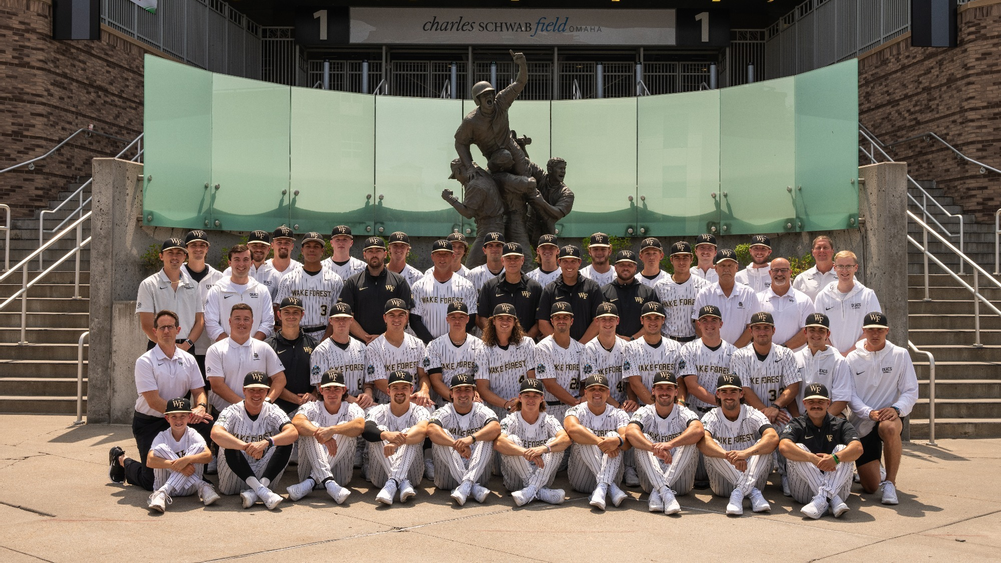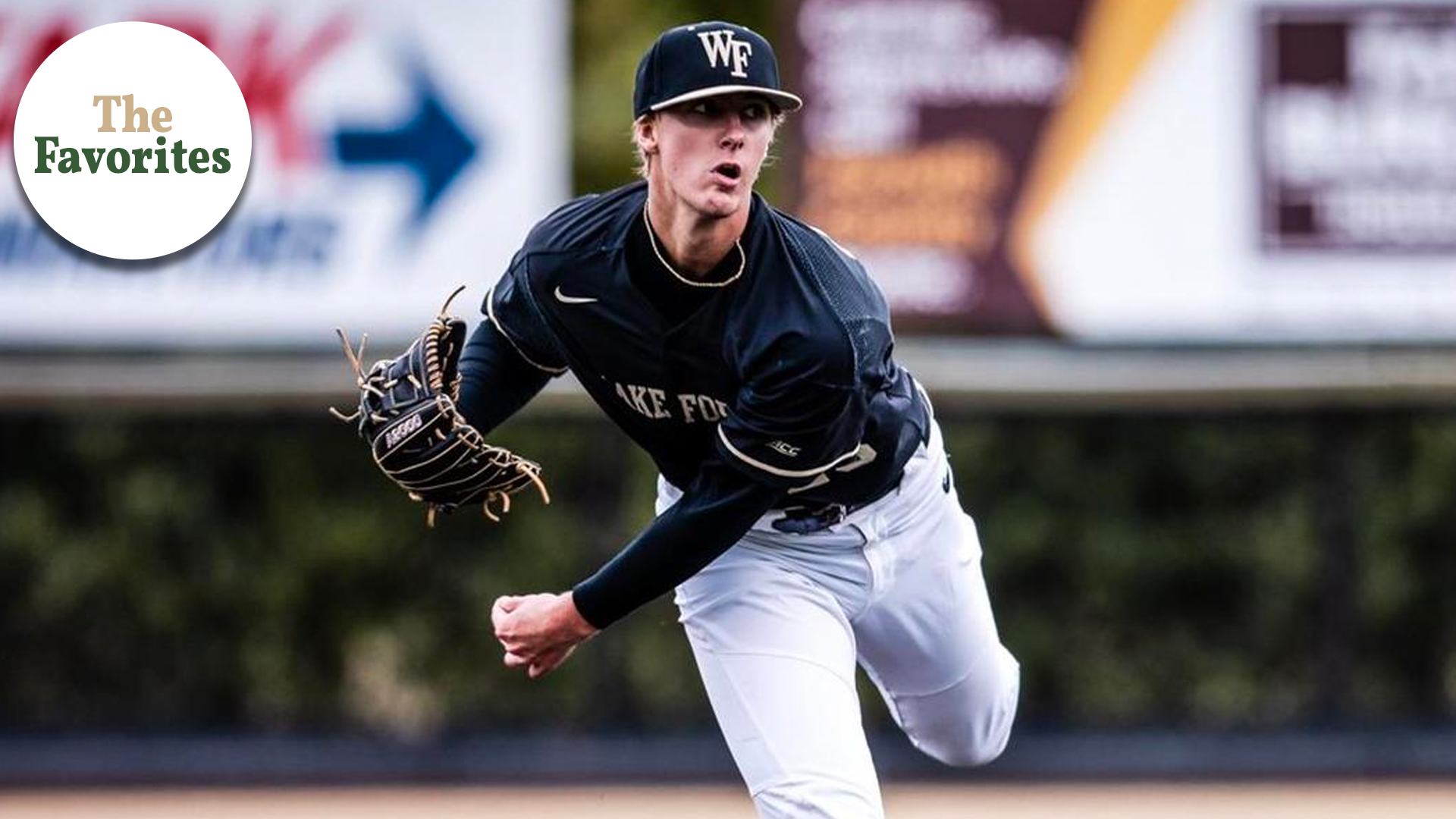The Favorites is a multi-part series taking a look at the teams picked to win their respective conferences. For all stories in the series, click here.
Wake Forest may very well be the poster boys of the future of analytics in college baseball. Everything that happens with their players is quantified. With their pitchers, data points ranging from the time between pitches to detailed biomechanical assessments to videos of specific drills are dutifully logged, categorized, and stored.
At any point in time, any coach can go in and retrieve what a player’s throwing motion looked like a month prior and overlay it with where they’re at today. They design drills around improving range of motion, stability, and more. They drill in on the mental game, focusing on things like breathing exercises, visualization, and meditation.
Each data point, paired with detailed advance scouting reports compiled by an MLB-esque 22-person analytics team, all feed into the core tenet espoused by pitching coach Corey Muscara: “How do we make our guys believe they’re the best version of themselves?”
The returns on investment driven forward by head coach Tom Walter, who took over in 2010 and has built the program to the point it enters 2024 as the preseason No. 1 team, have been marked. Last year, the Demon Deacons returned to the College World Series for the first time since 1955 and did so in style. They were the consensus top team throughout the course of the year and came up just short of a finals appearance after what amounted to a best-of-three with eventual champion LSU.

After a 41-win season the year prior, 2023 was a coming out party for Wake Forest on the national stage. The Demon Deacons went 54-12, ranking sixth in scoring and led the nation in ERA. They set program records in regular season wins, ACC wins, ACC series wins, postseason wins and overall wins. The program’s pitching lab, opened in 2018 in partnership with Wake Forest Baptist Medical Center, was a frequent topic on postseason broadcasts — and for good reason.
Look no further than Rhett Lowder, a lightly recruited righthander out of Albemarle, N.C., who emerged as one of the nation’s best pitchers during his time with Wake Forest. He went toe-to-toe with No. 1 pick Paul Skenes in the College World Series, matching him in what ultimately was an 11th-inning loss to the Tigers in a truly memorable game. The effect that the lab — headed by Dr. Kristen Nicholson — had on Lowder’s success can’t be overstated, but as Muscara will tell you, it’s not the whole story with the program’s rapid rise.

“We have our army of people that work hand-in-hand but the most important thing is to get guys to buy into the right mentality, the right culture, being competitive and understanding what it means to deal with adversity and what it means to be a team and celebrate others,” he said. “That’s really what’s been the biggest change over the last three years here. Making all decisions in everything we do — from how we talk to our team, to how we recruit, to how we prep for practice — centered around that philosophy.”
“[The lab] plays a part, but a pitching lab without the right culture doesn’t matter. You have to have the right things in place,” he added. “In the words of [Associate Head Coach] Bill Cilento, you have to make the main thing the main thing —the main thing is being good people and winning ballgames. We have to value that if that’s what we want to do.”
Finding that culture helps explain the turnaround from a disappointing 20-27 campaign in 2021, the third season in a row without an NCAA appearance. In 2022, the Demon Deacons reached regionals for the first time since 2017, which springboarded them into one of the best seasons in program history.
Now, even with program mainstays in Lowder, Brock Wilken, Sean Sullivan, Seth Keener, and others departing, the Demon Deacons still enter the year as the consensus preseason No. 1 with lofty ambitions to return to Omaha and get the job done. Those expectations can weigh heavily, but Muscara and the Wake Forest staff feel confident in their ability to keep the team focused — particularly by using the data and information they collect as guardrails of sorts.
“We want them to be confident, we want to pump them up, and we want them to have fun,” Muscara said. “At the same time, we have to have enough feel to try to keep them grounded and keep them focused. And you can do that with a lot of information if it’s used the right way.”

Expectations are high for good reason, starting with a weekend rotation that ranks as the nation’s best. Josh Hartle, Chase Burns, and Michael Massey form a trio of high-end arms — giving them a pitching advantage in pretty much any weekend series.
Hartle, recently named the nation’s top starting pitcher entering 2024 by D1 Baseball, has started since the day he arrived on campus. Last year, he turned in a 11-2 record with 140 strikeouts in 102-plus innings and a 2.81 ERA. Massey had a breakout 2023 campaign after transferring in from Tulane — his move to the bullpen paid off to the tune of a 47.2 K% and 2.59 ERA over 27 appearances. He’s got starting experience and is moving into one of the spots left open by Lowder and Sullivan’s departure.

Burns, meanwhile, was one of the nation’s highest-profile entries into the transfer portal after two seasons at Tennessee, and the development opportunity at Wake Forest likely had quite a bit of sway in his decision-making process. Muscara outlined their recruiting strategy in the portal, highlighting the availability of Trackman data and video footage to put together a comprehensive evaluation of a pitcher and point out areas where they can work with a prospect to improve their performance.
Burns didn’t have to look beyond his new rotation mate, Massey, for an example of the impact of the Demon Deacons development approach.. “We were able to watch [Massey’s] delivery and see some things on video that we felt like we could improve,” Muscara said. “We felt like if we improved those things in his delivery, that he would have better ball flight metrics — and if he got better ball flight metrics, his fastball would perform better.”
Reshaping Massey’s slider was another successful adjustment, while Sullivan and reliever Cole Roland enjoyed similar improvements after arriving from Northwestern and Dartmouth, respectively. In recruiting transfers like Burns, Muscara said, that was a strong selling point.
“When guys come in on their visits, we do a lot of these assessments before they get here,” Muscara added. “And then we show them how we would do it. We show them through all the videos and things that we track, all the drills that we’ve done with guys. We show them how we outlined it for them. And we show them the kind of improvement plans.”
“We show them here’s where they were before they were here,” he added. “Here’s where they were after. And because we track everything, it’s very black and white.”
The returns have been promising for Burns so far. After moving to the bullpen midway through his last year with the Vols due to some struggles, Burns is back in the rotation and appears better than ever. In a recent intrasquad scrimmage, Burns set Twitter ablaze with 10 strikeouts over four hitless innings. Unlocking the next level of a player like Burns, with the immense talent he already possesses, is a scary thought for lineups throughout the country.

Even with quite a few departures and new faces, it’s hard to look at Wake Forest’s lineup and worry too much. After all, the Demon Deacons are built around two likely first-round picks: first baseman Nick Kurtz and center fielder Seaver King, a D-II transfer.
All Kurtz has done since arriving in Winston-Salem is hit. He has a career .344 average across 109 games, clubbing 24 doubles, 37 home runs, and driving in 120 runs. King has done the same at the D-II level — at Wingate he had a career .398 batting average, a .453 on-base percentage, and added 61 extra base hits for good measure.
Any questions about making the jump to D-I were answered by King’s performance over the summer. He went 25-for-59 (.424) in 16 games on the Cape, then started 10 of 12 games for the US Collegiate National Team.

Around that duo the lineup is bolstered by transfers — including Wofford’s Cameron Gill, Ball State’s Adam Tellier, and Saint John’s Tate Ballestero — as well as returnees Marek Houston, Jack Winnay, and Jake Reinisch.
The newcomer-heavy group will have to gel quickly and fill big shoes. Wilken, Justin Johnson, Tommy Hawke, and Pierce Bennett, who started 60-plus games last season, are gone, along with a few other key contributors. Wake Forest is betting on the duo of Kurtz & King, alongside an intriguing blend of breakout candidates and proven D-I contributors.
Tellier hit .317/.394/.515 with the Cardinals, clubbing a career-high nine home runs in 2024. Gill had a career year in 2024, breaking out as an everyday player for the first time and posting a .929 OPS across 53 games. Ballestero is another veteran bat that started his career at Virginia and is also coming off his best statistical season in college, a .288/.413/.513 slash line with 10 home runs at Saint John’s.

If there is one question around Wake Forest heading into the year, it is around who comes in after one of the three-headed monster of a rotation hands over the ball.
Last season, you knew who you would be seeing out of the pen — one of a quartet of Massey, Roland, Keener, and elite closer Camden Minacci. Muscara joked that all you had to do was look down to the bullpen and pick who was freshest to close out the game. Now, with Massey in the rotation, Roland sidelined to start the year, and Keener/Minacci drafted, the Demon Deacons will be relying on some youthful arms to close out games.
“There are plenty of guys that have really good arm talent and really good stuff,” Muscara said of the new-look bullpen. “It’s just a matter of getting to understand the college scheme, understand their roles, and getting them comfortable in leverage situations.”
After Roland, the other veterans include Maryland’s Dave Falco — who’s no stranger to closing out games after logging nine saves a year ago — as well as Will Ray (18 app), Joe Ariola (17 app), and the 2022 stalwart Crawford Wade. Underclassmen poised for bigger roles this year include Zach Johnston and Ben Shenosky.

After that, Wake Forest will be putting quite a bit of faith in its true freshmen. The Demon Deacons have had plenty of success in developing arms and will look to continue that with Blake Morningstar, Andrew Koshy, Josh Gunther, and Haiden Leffew.
Morningstar could be the best of the bunch out of the bullpen, Leffew figures to take the midweek starting role should he not be utilized in leverage situations, and Koshy is an intriguing sidewinder. Ultimately, until the season gets underway, how these first-year arms will fare — and how Wake Forest’s bullpen does as a whole — will be fodder for discussions around their Omaha chances.
“I expect there to be some bumps,” Muscara said. “I expect there to be some moments where potentially the world hits the panic button because you’re number one, so you’re not ever supposed to have any hiccups, right?”
“But that’s life, that’s the game of baseball, it’s gonna happen,” he finished. “I think that once we weather those moments or those circumstances that we can utilize in a teaching moment, they’re gonna be way better off for it.”
One thing is certain: The way Wake Forest handles all aspects of its program — from data collection to detailed analysis to finding the best ways to tweak and consistently improve — is hard to bet against.
Featured Images Credit to Wake Forest Athletics

